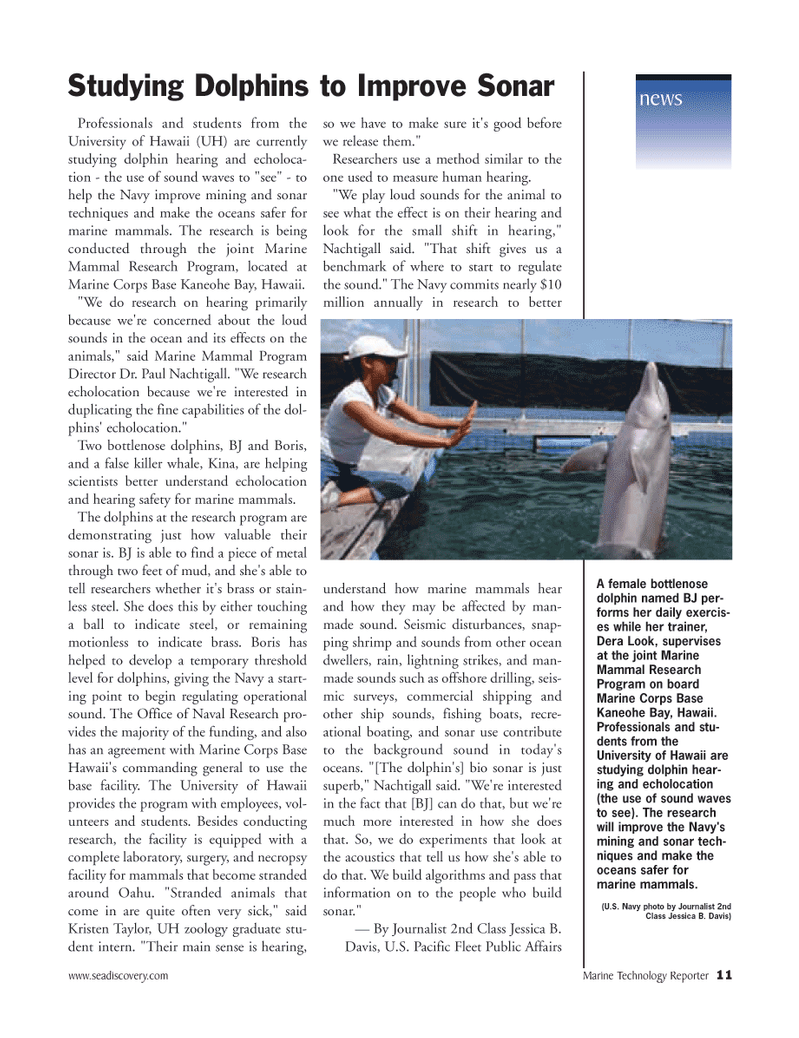
Page 11: of Marine Technology Magazine (September 2005)
Maritime Security & Undersea Defense
Read this page in Pdf, Flash or Html5 edition of September 2005 Marine Technology Magazine
www.seadiscovery.com Marine Technology Reporter 11 news
Professionals and students from the
University of Hawaii (UH) are currently studying dolphin hearing and echoloca- tion - the use of sound waves to "see" - to help the Navy improve mining and sonar techniques and make the oceans safer for marine mammals. The research is being conducted through the joint Marine
Mammal Research Program, located at
Marine Corps Base Kaneohe Bay, Hawaii. "We do research on hearing primarily because we're concerned about the loud sounds in the ocean and its effects on the animals," said Marine Mammal Program
Director Dr. Paul Nachtigall. "We research echolocation because we're interested in duplicating the fine capabilities of the dol- phins' echolocation."
Two bottlenose dolphins, BJ and Boris, and a false killer whale, Kina, are helping scientists better understand echolocation and hearing safety for marine mammals.
The dolphins at the research program are demonstrating just how valuable their sonar is. BJ is able to find a piece of metal through two feet of mud, and she's able to tell researchers whether it's brass or stain- less steel. She does this by either touching a ball to indicate steel, or remaining motionless to indicate brass. Boris has helped to develop a temporary threshold level for dolphins, giving the Navy a start- ing point to begin regulating operational sound. The Office of Naval Research pro- vides the majority of the funding, and also has an agreement with Marine Corps Base
Hawaii's commanding general to use the base facility. The University of Hawaii provides the program with employees, vol- unteers and students. Besides conducting research, the facility is equipped with a complete laboratory, surgery, and necropsy facility for mammals that become stranded around Oahu. "Stranded animals that come in are quite often very sick," said
Kristen Taylor, UH zoology graduate stu- dent intern. "Their main sense is hearing, so we have to make sure it's good before we release them."
Researchers use a method similar to the one used to measure human hearing. "We play loud sounds for the animal to see what the effect is on their hearing and look for the small shift in hearing,"
Nachtigall said. "That shift gives us a benchmark of where to start to regulate the sound." The Navy commits nearly $10 million annually in research to better understand how marine mammals hear and how they may be affected by man- made sound. Seismic disturbances, snap- ping shrimp and sounds from other ocean dwellers, rain, lightning strikes, and man- made sounds such as offshore drilling, seis- mic surveys, commercial shipping and other ship sounds, fishing boats, recre- ational boating, and sonar use contribute to the background sound in today's oceans. "[The dolphin's] bio sonar is just superb," Nachtigall said. "We're interested in the fact that [BJ] can do that, but we're much more interested in how she does that. So, we do experiments that look at the acoustics that tell us how she's able to do that. We build algorithms and pass that information on to the people who build sonar." — By Journalist 2nd Class Jessica B.
Davis, U.S. Pacific Fleet Public Affairs
Studying Dolphins to Improve Sonar
A female bottlenose dolphin named BJ per- forms her daily exercis- es while her trainer,
Dera Look, supervises at the joint Marine
Mammal Research
Program on board
Marine Corps Base
Kaneohe Bay, Hawaii.
Professionals and stu- dents from the
University of Hawaii are studying dolphin hear- ing and echolocation (the use of sound waves to see). The research will improve the Navy's mining and sonar tech- niques and make the oceans safer for marine mammals. (U.S. Navy photo by Journalist 2nd
Class Jessica B. Davis)
MTR#2 (1-16).qxd 8/30/2005 4:46 PM Page 13

 10
10

 12
12
